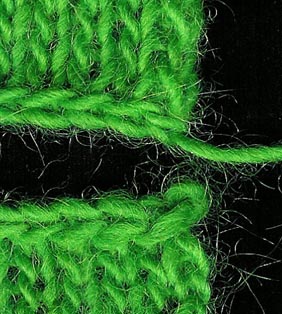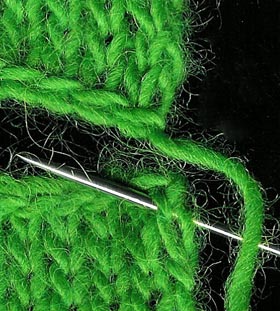| 19: Stitch to Stitch
or Horizontal Seams The first seam
you have to work can occur before you have knitted all the
pieces that make up the garment. If you are knitting a sweater,
cardigan or jacket with sleeves that are picked up around the
armholes and then knitted to the cuff, you will need to join the
shoulder seams before you can work the sleeves. As the shoulder is
usually a cast-off row, you will be joining stitch to stitch, making
a horizontal seam.
Because shoulder seams are in the area of the face they are very
obvious, and so it will be equally obvious if they are joined badly.
Unless the neck of a sweater is knitted separately and then sewn in
place, you will have to join one shoulder seam, then work the neck,
(see here) then join the second shoulder seam. Other methods are
to join both shoulder seams and then work the neck with double
pointed needles, or work the neck in two separate pieces.
---
The simplest shoulder shaping is worked by
casting off a row of stitches. Leave an end long enough to use for
the seam. If you have knitted correctly, the number of stitches on
each shoulder should be the same, so it should be very easy to work
a shoulder seam by matching stitch to stitch on each shoulder. This
sounds simple, and so it should be.
Some knitters backstitch the shoulder seam with the wrong side
facing. This does the job, the pieces are joined, but as it is
almost impossible to match the stitches from the wrong side, it will
be hard to get a perfectly matched seam.
To match the stitches, place the two pieces, right side facing, into
position ready to join. If you have knitted from hem to shoulder,
the stitch is a V shape, but when one piece is above the other ready
to be joined, the V shape of the stitches is reversed on the top
piece. If you have cast off with the right side facing, the long end
will be at the right hand side of the top piece [pic 1,2].


1: (left) Pieces in position to begin cast-off row to
cast-off row seam.
2: (right) V and inverted V stitch
shapes.
Joining an almost invisible shoulder seam is
very easy. The trick is to ignore the cast off row. It is only there
to stop the stitches below it from unravelling, and there is no need
to include it in the shoulder seam. The stitches you will use for
the seam are the stitches of the last row before the cast-off row.
There are two ways to join this seam. The first one I will explain
is very good and hard to beat, the second way is my extra-fussy
knitter way.
The first stitch, on the right edge of the lower piece is in the
shape of a V. Using the thread from the top piece, place the needle
behind the first stitch under the cast-off row on the lower piece
from right to left, and bring the needle and thread through to the
front of the work [pic 3].

3: Using thread from top piece, place needle from
right to left behind first entire stitch and bring thread through to
front of work.
NEXT PAGE >>
chapter page: 1 | 2 |
3 | 4 |
5 | 6 |
7
|